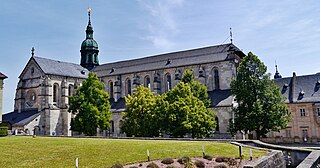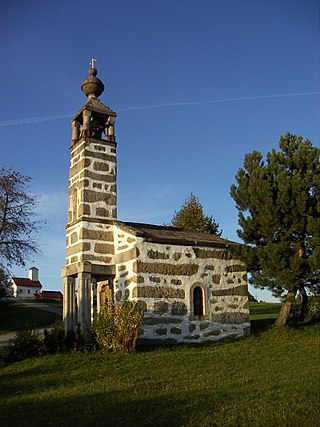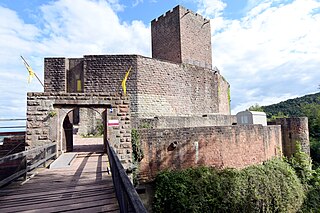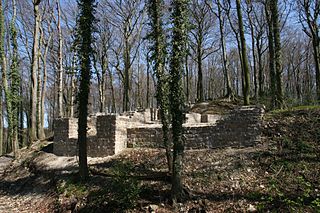
Ebrach Abbey is a former Cistercian monastery in Ebrach in Oberfranken, Bavaria, Germany, now used as a young offenders' institution.

Weiding is a municipality in the district of Schwandorf in Bavaria, Germany.

Weitersfelden is a municipality in the district of Freistadt in the Mühlviertel in the Austrian state of Upper Austria.

Schloss Köpenick is a Baroque water palace of the Hohenzollern electors of Brandenburg which stands on an island in the Dahme River surrounded by an English-style park and gives its name to Köpenick, a district of Berlin.

Bergpark Wilhelmshöhe is a landscape park in Kassel, Germany. The area of the park is 2.4 square kilometres, making it the largest European hillside park, and second largest park on a hill slope in the world. Construction of the Bergpark, or "mountain park", began in 1689 at the behest of the Landgraves of Hesse-Kassel and took about 150 years. The park is open to the public today. Since 2013, it has been a UNESCO World Heritage Site because of its monumental Baroque architecture and its unique fountains and water features.

The Hardenburg on the eastern edge of the Palatinate Forest near the Rhineland-Palatinate town of Bad Dürkheim is even as a ruin one of the mightiest castles of Palatinate.
Martin Weber was a German architect who designed Catholic churches.

The Orangerie is an orangery in Kassel, Hesse, Germany. It was built under Landgrave Charles between 1703 and 1711. Since then, it forms the northern corner of the Karlsaue park. Today it is used as an astronomy and physical cabinet.

Landeck Castle is a ruined hill castle southwest of Landau, near Klingenmünster in the county of Südliche Weinstraße in the German state of Rhineland-Palatinate.
Forchheim Fortress was laid out after the occupation of the town of Forchheim during the Second Margrave War (1552) by the Bishopric of Bamberg. Today about one third of the fortification works have survived and have been incorporated into the municipal parks.

The Altenberger Dom is the former abbey church of Altenberg Abbey which was built from 1259 in Gothic style by Cistercians. Listed as a cultural heritage, it is located in Altenberg, now part of Odenthal in the Rheinisch-Bergischer Kreis, North Rhine-Westphalia, Germany. Until 1511, the church was the burial site of counts and dukes of Berg and the dukes of Jülich-Berg.

The Holter Burg is the oldest castle site in the municipality of Bissendorf near Osnabrück in the German state of Lower Saxony. It is the ruin of a hill castle. It was the third hill castle in Osnabrück Land along with the Iburg and the Wittekindsburg near Rulle.

Bad Homburg Castle is a castle and palace in the German city of Bad Homburg vor der Höhe. Originally the residence of the Landgraves of Hesse-Homburg, it was first built in the 12th century.

St. Leonhard is a parish of the Roman Catholic Church in Frankfurt, Hesse, Germany. Its historic church dates to 1219, when it was erected in the centre of the town close to the river Main, as a Romanesque-style basilica. From 1425, it was remodeled to a hall church in late Gothic style. St. Leonhard was the only one of nine churches in the Old Town that survived World War II almost undamaged. Today, the parish is part of the Domgemeinde and serves as the parish church of English-speaking Catholics. It is a monument of Frankfurt's history as well as church history and medieval crafts.

Halle Cathedral is the oldest surviving church in the old part of the city Halle, Saale. Beside it resided the Archbishop of Magdeburg, who ruled the city for a long period. Albert of Brandenburg remodelled the church's exterior from 1520 onwards and built the neighbouring Neue Residenz, aiming to make the church one of the most influential and powerful monasteries north of the Alps.

The St. Peter and Paul cathedral is the largest medieval church in Brandenburg an der Havel, Brandenburg, Germany. Construction began in 1165 as a Romanesque Saalkirche. It was expanded several times to a three-aisled Brick Gothic basilica. The cathedral is commonly designated “the cradle of the Mark Brandenburg” for its historic significance. The patron saints are Peter and Paul.

Udo Mainzer is a German art historian and monument conservator. He held office until September 2011. as director of the LVR-Amt für Denkmalpflege im Rheinland and Landeskonservator of the Landschaftsverband Rheinland.
Paul-Georg Custodis is a German architect and historic preservationist.

The Reglerkirche is a church building in the historical centre of Erfurt in Thuringia, Germany. It serves a Lutheran parish as a place of worship and is one of the larger churches in the city's old part. In times of East Germany, it was considered a centre of church music in Erfurt.





















